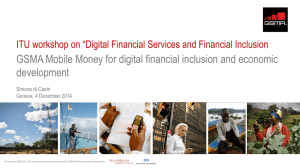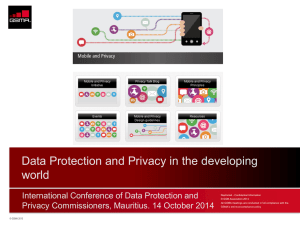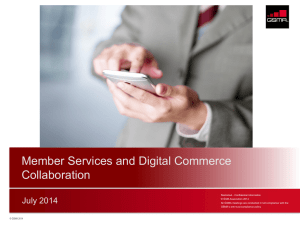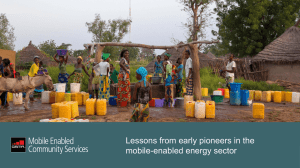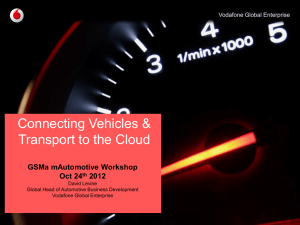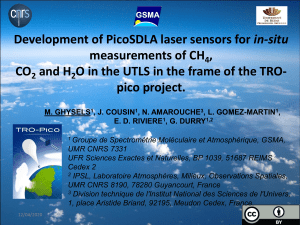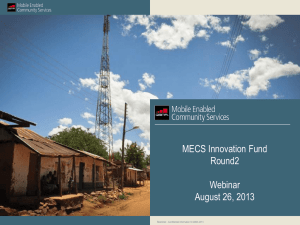GSMA and Digital Commerce Overview
advertisement
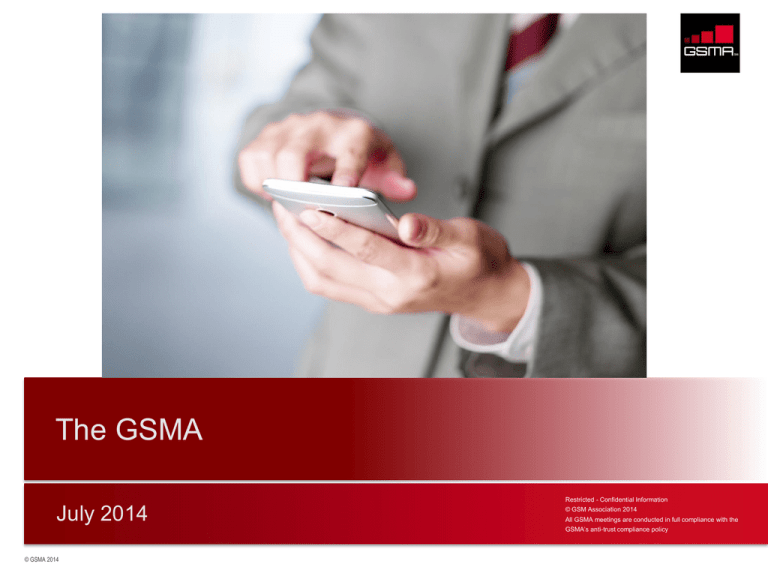
The GSMA Restricted - Confidential Information July 2014 © GSM Association 2014 All GSMA meetings are conducted in full compliance with the GSMA’s anti-trust compliance policy © GSMA 2014 The GSMA © GSMA 2014 Why Mobile Operators? © GSMA 2014 Substantial distribution channels to provide Digital Commerce enabled services, and have sufficient economies of scale to provide mobile contactless to all Customer care infrastructure providing consumers with a trusted transaction partner resolving any issues relating to their mobile services Technical infrastructure for the provisioning and management of SIM cards and ensuring adequate security Substantial experience in standards-based and interoperable services, enabling strong ecosystem development based on the mobile platform The GSMA’s Vision We connect… The digital and physical worlds. We enable and provide… Secure, smart and seamless services. We create… Opportunities and prosperity for all. We are your trusted partner. © GSMA 2014 The GSMA Vision 2020 framework Digital Futurescape Personal Data Become the secure guardians of consumer data • Develop a webbased and SIMbased digital authentication solution Connected Living Connect the digital and physical worlds • • © GSMA 2014 Develop Machine SIM (MIM) to enable the Internet of Things Define Internet of Things network requirements Digital Commerce Network 2020 Enable and build the digital commerce ecosystem Create the network for secure, smart and seamless services • • Create standardised B2B wallet interfaces Develop Mobile Money Interoperability • Make Operator IP Communications work as a native service • Develop and implement technical standard for Quality of Service (QoS) Digital Commerce Initiative Restricted - Confidential Information July 2014 © GSM Association 2014 All GSMA meetings are conducted in full compliance with the GSMA’s anti-trust compliance policy © GSMA 2014 The GSMA’s Digital Commerce Initiative From Vision 2020’s development, two priority initiatives were identified for digital commerce: In mature markets, become the trusted mediator – creation of a mobile commerce ecosystem where operators become trusted mediators between consumers and service providers integrating stores of value and enabling commerce personalisation. In emerging markets, create the mobile money ecosystem – creation of a digital financial ecosystem, with operators bringing significant value, in which mobile money replaces a large proportion of cash transactions. To address the very different market needs, the Digital Commerce initiative will be delivered by two programmes, B2B Wallet Interfaces and Mobile Money Interoperability. © GSMA 2014 B2B Wallet Interfaces Programme NFC is just a small part of what is happening in digital commerce: Mobile wallets, mobile payments, transport ticketing, retail loyalty and couponing services, parking and other services are being rolled out using a wide range of technology solutions. Alongside NFC, increasingly popular solutions for digital commerce include: – Bluetooth low energy (BLE) eg iBeacons – QR codes and barcodes – Web-based / online services – Proprietary products eg Apple’s Passbook – Mobile point of sales services eg Square, handset based mPOS. It’s almost impossible to list all the digital commerce services — in Europe alone there are already more than 250 live digital commerce services compared to 300 NFC services globally. © GSMA 2014 Consumers and service providers alike need simplicity, consistency and relevance © GSMA 2014 Mobile operators will use digital commerce services and mobile wallet offerings as competitive and differentiated customer propositions. In order to attract service providers, consistency and scale are essential on the B2B side. A global proposition is needed to drive adoption and scale, embodied by a set of common B2B interfaces deployed by all operators in the same market. GSMA Digital Commerce Retail 2014 To support the Digital Commerce B2B Interfaces Programme objective: Engage with the digital commerce ecosystem to stimulate the development and onboarding of service applications using operator interfaces. © GSMA 2014 Define the core functionality and technology to enable mobile couponing and loyalty (in both on and off line states). Determine a mobile solution for multi-merchant/operator coupon distribution and acceptance. Develop an ‘In-Store Shopper Journey’. Support mobile operator trials and go-to-market activities in selected markets. GSMA Digital Commerce Transport 2014 To support the Digital Commerce B2B Interfaces Programme objective: Engage with the digital commerce ecosystem to stimulate the development and onboarding of service applications using operator interfaces using the following methods. © GSMA 2014 Identify requirements for transport by conducting an impact assessment detailing technology/ capability/ market requirements to support interoperable ticketing & access solutions. Develop B2B propositions which meet the identified needs of service providers and mobile operators leading to the deployment of a service implementation toolkit via: – Determining the corresponding architecture and identifying the interfaces where standardisation will bring value. – Specifying the corresponding APIs and business processes. Collate best practice and develop strategies to support its’ adoption and implementation by mobile operators and the transport ecosystem. GSMA Digital Commerce Simplification 2014 To support the Digital Commerce B2B Interfaces Programme objective: Simplified service on boarding is focusing on reducing the complexity of mobile financial services, and will address both the development of guidelines or specifications as well as the End to End testing. The focus of the project is primarily payment/financial services simplification, but should also cover other SIM-based solutions such as transport, retail loyalty etc. The main objectives are: Define what are the simplification requirements and recommend the preferred options. Document and specify selected simplification options. Help develop comprehensive test plans for Trusted Service Managers (TSMs), SIMs, handsets, and end to end services. The project will focus on the following work packages: Guidelines for shared TSMs and TSM hubs. Specifications and recommended options to simplify current business and technical ecosystem (TSM, SIM). End to End test specifications involving other key players as required. © GSMA 2014 Mobile Money Interoperability Programme The mobile money landscape is becoming increasingly competitive with 52 markets having 2 or more mobile money schemes at the end of 2013 © GSMA 2014 Mobile Money Interoperability - FY2014 Definition Objectives $ 1 Develop enablers of A2A mobile money interoperability Economic case for interoperability and “how to” guides: Commercial models, technical architectures, operational guides and regulatory considerations. 2 Support selected markets to achieve 5 commitments and 3 launches for A2A interoperability In-country commercial, technical and regulatory support to facilitate commitment and implementation of interoperable wallets. 3 Create enablers for ecosystem development Assess ecosystem needs, undertake gap analysis on current offerings and provide guidelines on exposing mobile money to third parties with APIs. 4 Engage with ecosystem stakeholders to promote the role of operators in the ecosystem Encourage third parties to digitise payments and use the mobile money ecosystem developed by operators. MMO B MMO A $ MMO C BANKS Mobile Money Platform Companies who want to use mobile money in their solutions 5 © GSMA 2014 Activities Evaluate longer term strategic industry opportunities Conduct strategic assessment / feasibility of post FY 2014 mobile money opportunities. Any questions? Thank you digitalcommerce@gsma.com © GSMA 2014
